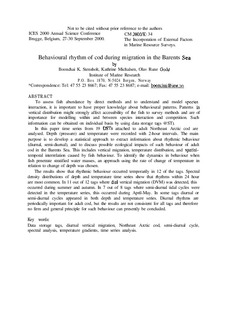| dc.contributor.author | Stensholt, Boonchai K. | |
| dc.contributor.author | Michalsen, Kathrine | |
| dc.contributor.author | Godø, Olav Rune | |
| dc.date.accessioned | 2012-10-18T05:56:09Z | |
| dc.date.available | 2012-10-18T05:56:09Z | |
| dc.date.issued | 2000 | |
| dc.identifier.citation | This report is not to be cited without prior reference to the authors | no_NO |
| dc.identifier.uri | http://hdl.handle.net/11250/106089 | |
| dc.description.abstract | To assess fish abundance by direct methods and to understand and model species
interaction, it is important to have proper knowledge about behavioural patterns. Patterns in
vertical distribution might strongly affect accessibility of the fish to survey methods and are of
importance for modelling within and between species interaction and competition. Such
information can be obtained on individual basis by using data storage tags DST).
In this paper time series from 19 DSTs attached to adult Northeast Arctic cod are
analysed. Depth (pressure) and temperature were recorded with 2-hour intervals. The main
purpose is to develop a statistical approach to extract information about rhythmic behaviour
(diurnal, semi-diurnal), and to discuss possible ecological impacts of such behaviour of adult
cod in the Barents Sea. This includes vertical migration, temperature distribution, and spatialtemporal
interrelation caused by fish behaviour. To identify the dynamics in behaviour when
fish penetrate stratified water masses, an approach using the rate of change of temperature in
relation to change of depth was chosen.
The results show that rhythmic behaviour occurred temporarily in 12 of the tags. Spectral
density distributions of depth and temperature time series show that rhythms within 24 hour
are most common. In 11 out of 12 tags where diel vertical migration (DVM) was detected, this
occurred during summer and autumn. In 7 out of 8 tags where semi-diurnal tidal cycles were
detected in the temperature series, this occurred during April-May. In some tags diurnal or
semi-diurnal cycles appeared in both depth and temperature series. Diurnal rhythms are
periodically important for adult cod, but the results are not consistent for all tags and therefore
no firm and general principle for such behaviour can presently be concluded. | no_NO |
| dc.language.iso | eng | no_NO |
| dc.publisher | ICES | no_NO |
| dc.relation.ispartofseries | ICES CM Documents;2000/K:34 | |
| dc.subject | cod | no_NO |
| dc.subject | torsk | no_NO |
| dc.subject | fish behaviour | no_NO |
| dc.subject | fiskeatferd | no_NO |
| dc.subject | fish migration | no_NO |
| dc.subject | vandringer | no_NO |
| dc.subject | Barents Sea | no_NO |
| dc.subject | Barentshavet | no_NO |
| dc.subject | stock assessment | no_NO |
| dc.subject | bestandsberegning | no_NO |
| dc.title | Behavioural rhythm of cod during migration in the Barents Sea | no_NO |
| dc.type | Working paper | no_NO |
| dc.subject.nsi | VDP::Mathematics and natural science: 400::Zoology and botany: 480::Ethology: 485 | no_NO |
| dc.subject.nsi | VDP::Mathematics and natural science: 400::Geosciences: 450::Oceanography: 452 | no_NO |
| dc.subject.nsi | VDP::Mathematics and natural science: 400::Mathematics: 410::Analysis: 411 | no_NO |
| dc.source.pagenumber | 30 s. | no_NO |
